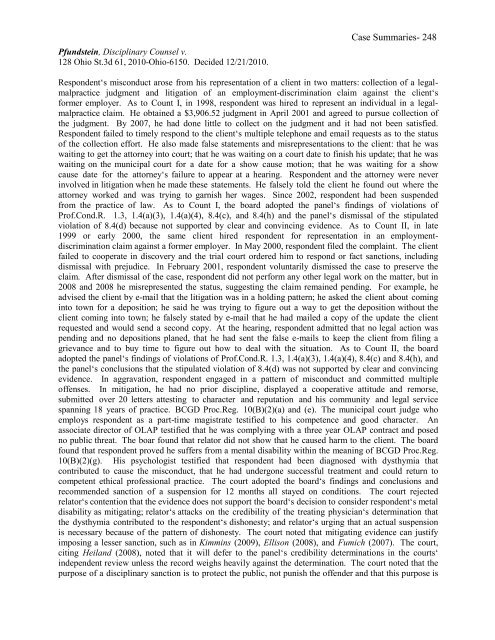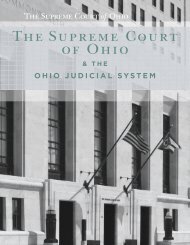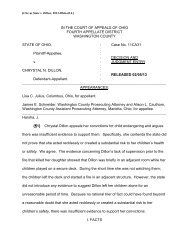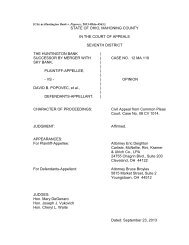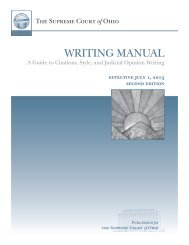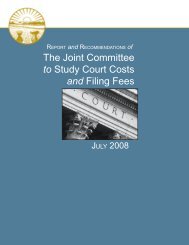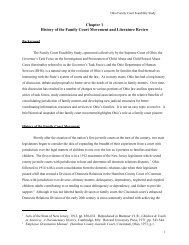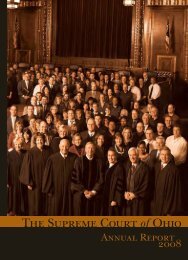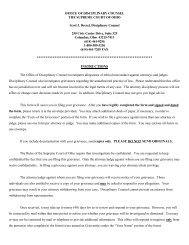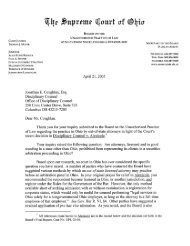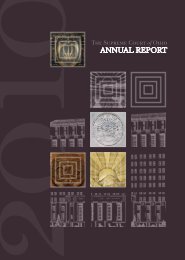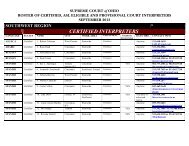disciplinary handbook: volume v - Supreme Court - State of Ohio
disciplinary handbook: volume v - Supreme Court - State of Ohio
disciplinary handbook: volume v - Supreme Court - State of Ohio
Create successful ePaper yourself
Turn your PDF publications into a flip-book with our unique Google optimized e-Paper software.
Pfundstein, Disciplinary Counsel v.<br />
128 <strong>Ohio</strong> St.3d 61, 2010-<strong>Ohio</strong>-6150. Decided 12/21/2010.<br />
Case Summaries- 248<br />
Respondent‘s misconduct arose from his representation <strong>of</strong> a client in two matters: collection <strong>of</strong> a legalmalpractice<br />
judgment and litigation <strong>of</strong> an employment-discrimination claim against the client‘s<br />
former employer. As to Count I, in 1998, respondent was hired to represent an individual in a legalmalpractice<br />
claim. He obtained a $3,906.52 judgment in April 2001 and agreed to pursue collection <strong>of</strong><br />
the judgment. By 2007, he had done little to collect on the judgment and it had not been satisfied.<br />
Respondent failed to timely respond to the client‘s multiple telephone and email requests as to the status<br />
<strong>of</strong> the collection effort. He also made false statements and misrepresentations to the client: that he was<br />
waiting to get the attorney into court; that he was waiting on a court date to finish his update; that he was<br />
waiting on the municipal court for a date for a show cause motion; that he was waiting for a show<br />
cause date for the attorney‘s failure to appear at a hearing. Respondent and the attorney were never<br />
involved in litigation when he made these statements. He falsely told the client he found out where the<br />
attorney worked and was trying to garnish her wages. Since 2002, respondent had been suspended<br />
from the practice <strong>of</strong> law. As to Count I, the board adopted the panel‘s findings <strong>of</strong> violations <strong>of</strong><br />
Pr<strong>of</strong>.Cond.R. 1.3, 1.4(a)(3), 1.4(a)(4), 8.4(c), and 8.4(h) and the panel‘s dismissal <strong>of</strong> the stipulated<br />
violation <strong>of</strong> 8.4(d) because not supported by clear and convincing evidence. As to Count II, in late<br />
1999 or early 2000, the same client hired respondent for representation in an employmentdiscrimination<br />
claim against a former employer. In May 2000, respondent filed the complaint. The client<br />
failed to cooperate in discovery and the trial court ordered him to respond or fact sanctions, including<br />
dismissal with prejudice. In February 2001, respondent voluntarily dismissed the case to preserve the<br />
claim. After dismissal <strong>of</strong> the case, respondent did not perform any other legal work on the matter, but in<br />
2008 and 2008 he misrepresented the status, suggesting the claim remained pending. For example, he<br />
advised the client by e-mail that the litigation was in a holding pattern; he asked the client about coming<br />
into town for a deposition; he said he was trying to figure out a way to get the deposition without the<br />
client coming into town; he falsely stated by e-mail that he had mailed a copy <strong>of</strong> the update the client<br />
requested and would send a second copy. At the hearing, respondent admitted that no legal action was<br />
pending and no depositions planed, that he had sent the false e-mails to keep the client from filing a<br />
grievance and to buy time to figure out how to deal with the situation. As to Count II, the board<br />
adopted the panel‘s findings <strong>of</strong> violations <strong>of</strong> Pr<strong>of</strong>.Cond.R. 1.3, 1.4(a)(3), 1.4(a)(4), 8.4(c) and 8.4(h), and<br />
the panel‘s conclusions that the stipulated violation <strong>of</strong> 8.4(d) was not supported by clear and convincing<br />
evidence. In aggravation, respondent engaged in a pattern <strong>of</strong> misconduct and committed multiple<br />
<strong>of</strong>fenses. In mitigation, he had no prior discipline, displayed a cooperative attitude and remorse,<br />
submitted over 20 letters attesting to character and reputation and his community and legal service<br />
spanning 18 years <strong>of</strong> practice. BCGD Proc.Reg. 10(B)(2)(a) and (e). The municipal court judge who<br />
employs respondent as a part-time magistrate testified to his competence and good character. An<br />
associate director <strong>of</strong> OLAP testified that he was complying with a three year OLAP contract and posed<br />
no public threat. The boar found that relator did not show that he caused harm to the client. The board<br />
found that respondent proved he suffers from a mental disability within the meaning <strong>of</strong> BCGD Proc.Reg.<br />
10(B)(2)(g). His psychologist testified that respondent had been diagnosed with dysthymia that<br />
contributed to cause the misconduct, that he had undergone successful treatment and could return to<br />
competent ethical pr<strong>of</strong>essional practice. The court adopted the board‘s findings and conclusions and<br />
recommended sanction <strong>of</strong> a suspension for 12 months all stayed on conditions. The court rejected<br />
relator‘s contention that the evidence does not support the board‘s decision to consider respondent‘s metal<br />
disability as mitigating; relator‘s attacks on the credibility <strong>of</strong> the treating physician‘s determination that<br />
the dysthymia contributed to the respondent‘s dishonesty; and relator‘s urging that an actual suspension<br />
is necessary because <strong>of</strong> the pattern <strong>of</strong> dishonesty. The court noted that mitigating evidence can justify<br />
imposing a lesser sanction, such as in Kimmins (2009), Ellison (2008), and Fumich (2007). The court,<br />
citing Heiland (2008), noted that it will defer to the panel‘s credibility determinations in the courts‘<br />
independent review unless the record weighs heavily against the determination. The court noted that the<br />
purpose <strong>of</strong> a <strong>disciplinary</strong> sanction is to protect the public, not punish the <strong>of</strong>fender and that this purpose is


